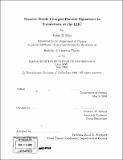Massive stable charged particle signatures in simulations at the LHC
Author(s)
Silva, James B. (James Brian)
DownloadFull printable version (6.870Mb)
Other Contributors
Massachusetts Institute of Technology. Dept. of Physics.
Advisor
Gunther M. Roland.
Terms of use
Metadata
Show full item recordAbstract
The importance of heavy stable charged (HSCP) particles lies in the exploration of extensions to the standard model. Extensions of the standard model attempt to solve current problems in the standard model such as the Hierarchy Problem. The Hierarchy Problem centers on the lack of an explanation in the standard model for the weakness of the force of gravity compared to the other forces of nature. Current research in particle physics has been directed at investigating the phenomenon of black hole production predicted by Extra Dimension Models that attempt to resolve the Hierarchy problem. The Large Hadron Collider (LHC) at CERN will allow the TeV energy range to be explored where black hole production might begin to occur at a significant rate as predicted by Large Extra Dimension (LED) models. The LED models center around the concept of a N dimensional universe where N > 3, by introducing the concept that the force of gravity can be diluted by the (N - 3) dimensions, thus solving the Hierarchy Problem. Horst Stocker and Benjamin Koch have published predictions on production of black holes using PYTHIA[2] and CHARYBDIS in protonproton collisions as well as heavy ion events such as Pb+Pb in the Koch paper. Other papers been published that are general survey on black holes at the Large Hadron Collider. These surveys describe the yield rates of mini black holes, motivation for mini black hole production, and possible characteristics of mini black holes in detector data. The analysis of heavy stable charged particles in this project is based on a "muon-like" HSCP 500GeV particle. A "muon-like" particle is a particle that has identical properties to that of a muon, but possesses a different rest mass. The Reissner-Nordstr6m metric describes empty space surrounding a charged black hole as described by Chandrasekhar's. It is possible to estimate the radius of a charged black hole as G by finding the horizon in the Reissner-Nordstrom metric. The radius of 500GeV muon like particle would then be approximately 1.188. 10- 28cm in comparison to the values 10- 32cm and 10- 3 6cm for a muon and electron respectively. This gives an idea of the relative size of radii of theoretical black holes that are proportional to the Gravitational constant. According to Large Extra Dimension theories the actual value of G may be in reality greater than that observed therefore the radii may be in the range such that a muon-like 500GeV particle would be a quantum black hole. The actual energy levels at which this quantum black hole production may occur varies in different extra dimension theories. However, the implications of large extra dimension theories are that heavy particles can exhibit black hole like behavior. The analysis of massive particles is only minimally related to these implications as there are many more motivations for the analysis of such heavy particles. The use of massive particles to study the Higgs field has also been proposed. The Exotica group in the CMS collaboration has prepared to analyze heavy stable charged particles, black holes, and heavy neutrinos. In this project I expand on some of the techniques developed by the Exotica group and the developers of the custom physics package for the CMSSW analysis framework in the CMS collaboration. In this project I have simulated events using the CMS event generation framework to explore the signatures of heavy stable charged particles at CERN. This project is part of the search for massive stable charged particles in the CMS collaboration. The analysis of data in this project centers on the energy loss of leptons and lepton-like particles created by using extensions to the standard generation resources in CMS. The analysis begins with the determination of the energy loss and momentum. The energy loss of the particles distinguishes the particles in multiple sections of the detector. The analysis then proceeds to study the muons at momentum ranges where the particles can be distinguished and follows correlations in the energy loss. The average of this correlated energy loss is then calculated to determine areas of interest for distinguishing heavy stable charge particles and the standard muon. The project expands on current research by elaborating on Stockers paper using the simulations to guide possible analysis of CMS data.
Description
Thesis (S.B.)--Massachusetts Institute of Technology, Dept. of Physics, 2008. Includes bibliographical references (p. 31-32).
Date issued
2008Department
Massachusetts Institute of Technology. Department of PhysicsPublisher
Massachusetts Institute of Technology
Keywords
Physics.